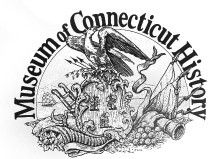In 1839, fifty-three African captives, illegally sold into slavery and being transported off Cuba, revolted and took La Amistad north. Near Long Island, they were seized by a U. S. Navy vessel and brought to Connecticut. Spain pressed for the return of the ship and its cargo, including the Africans. Over the next two years, their story and the legal case that ensued captured the imagination of the public, and abolitionists, churches, townspeople and college students mobilized in their support. Roger Sherman Baldwin and former President John Quincy Adams won a landmark United States Supreme Court case freeing the Africans, who were eventually able to realize their wish to return to Africa.
Constructed at Mystic Seaport, and launched in 2000, a replica of the Cuban ship La Amistad, the Amistad, was designated Connecticut’s State Flagship and Tall Ship Ambassador by vote of the General Assembly in 2003. The Freedom Schooner Amistad sails on an educational mission to ports around the country from its homeport in New Haven. Freedom Schooner Amistad is owned by AMISTAD America, Inc., a non-profit educational organization. It was built through the cooperation of several Connecticut institutions, with the support of numerous corporate and non-profit sponsors, to commemorate the story of the Amistad, to symbolize freedom and to promote tolerance and goodwill through its voyages and educational programs.
This research guide was created to assist researchers in identifying materials relating to La Amistad held by the State Library. They include:
· The Amistad Incident: Four Perspectives. Middletown, CT: Connecticut Humanities Council, 1992 [CSL call number AS 36 .C8 A1 no. 10].
· Adams, John Quincy. Argument of John Quincy Adams before the Supreme Court of the United States, in the Case of the United States, Appellants, vs. Cinque, and Others, Africans, Captured in the Schooner Amistad. New York: S. W. Benedict, 1841 [CSL call number SpecColl E 447 .A21 1841].
· Baldwin, Roger Sherman. Argument of Roger S. Baldwin of New Haven Before the Supreme Court of the United States, in the Case of the United States, Appellants, vs. Cinque, and Others, Africans, of the Amistad. New York: S. W. Benedict, 1841 [CSL call number SpecColl E 446 .B18 1841].
· Baldwin, Simeon E. “The Captives of the Amistad.” Papers of the New Haven Colony Historical Society 4 (1888): 331-70 [CSL call number F 98 .N49].
· Barber, John W. A History of the Amistad Captives. New Haven: E. L. and J. W. Barber, 1840 [CSL call number Cage K 540 .M5 v. 22].
· Cable, Mary. Black Odyssey: The Case of the Slave Ship Amistad. New York: Viking Press, 1971 [CSL call number E 447 .C24 1971].
· Cook, Fred J. “The Slave Ship Rebellion.” American Heritage 8 (Feb. 1957) 2:61-64 [CSL call number E 171 .A41].
· Jones, Howard. Mutiny on the Amistad: The Saga of a Slave Revolt and Its Impact on American Abolition, Law, and Diplomacy. New York: Oxford University Press, 1987 [CSL call number E 447 .J66 1987].
· Martin, Christopher. The Amistad Affair. New York: Abelard-Schuman, 1970 [CSL call number E 447 .M35 1970].
· Norton, Charles Ledyard. “Cinquez — Black Prince.” Farmington Magazine 1 (Feb. 1901) 4:2-5 [CSL call number F 104 .F4 F38].
· Owens, William. Black Mutiny: The Revolt on the Schooner Amistad. Baltimore: Black Classic Press, 1997 [CSL call number E 447 .O9 1997].
· Pettibone, Giles. Copy of Translation of License to Capt. Ramon Ferrer of Schooner Amistad to Make a Voyage from Havana to Guanaja and Return [CSL call number Main Vault 326 Am57].
· Rukeyser, Muriel. “The ‘Amistad’ Mutiny”, in Willard Gibbs. Garden City, NY: Doubleday, Doran & Company, Inc., 1942, Chapter 2, pp. 16-46 [CSL call number QC 16 .G5 R8].
· United States. Circuit Court (2nd Circuit). The African Captives, Trial of the Prisoners of the Amistad on the Writ of Habeas Corpus, Before the Circuit Court of the United States, for the District of Connecticut, at Hartford; Judges Thompson and Judson. September Term, 1839 [CSL call number SpecColl E 446 .U54 1839].
· Walton, Perry. “The Mysterious Case of the Long, Low, Black Schooner.” New England Quarterly 6 (June, 1933) 3:353-61 [CSL call number F 1 .N62 microfilm].
